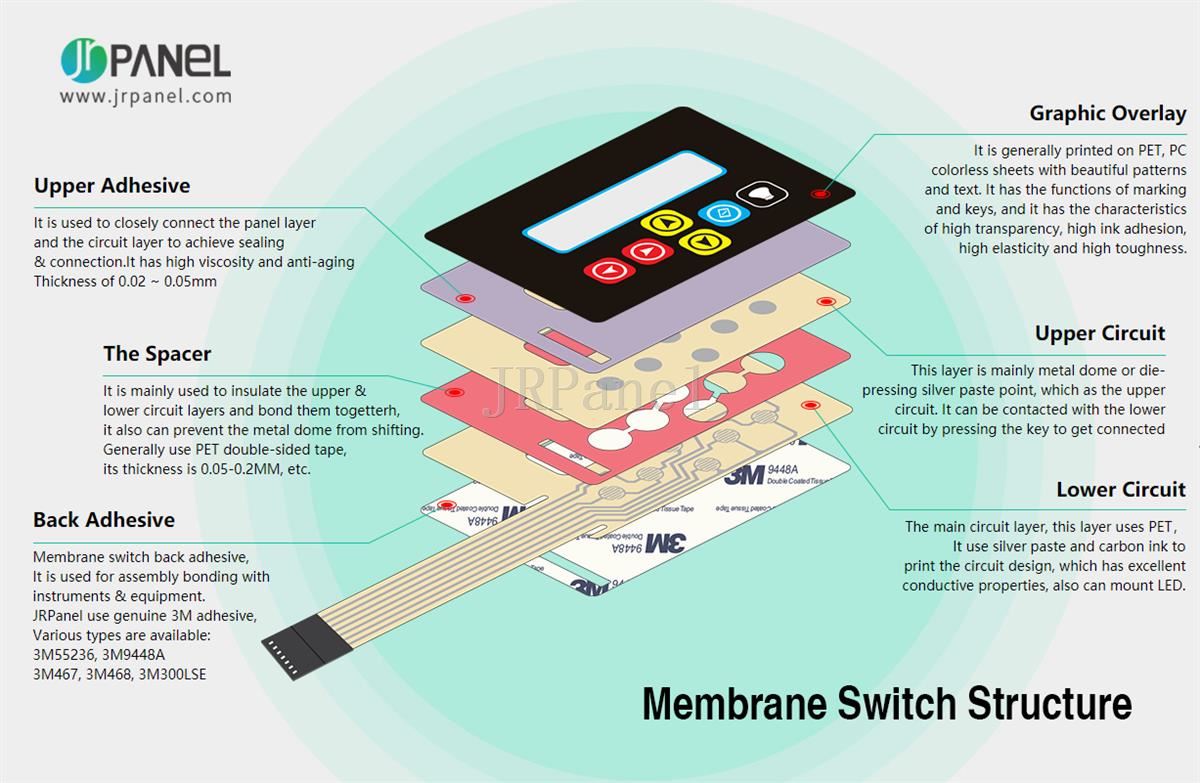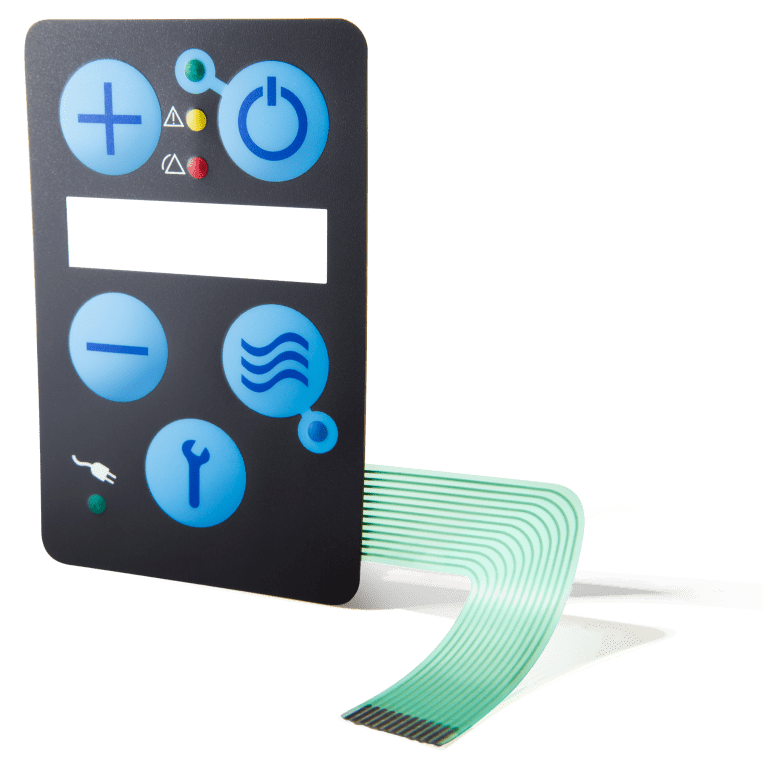The Manufacturing Refine Behind Membrane Change: What You Need to Know
The production process behind membrane layer switches combines mindful style, product selection, and top quality control. It begins with recognizing the ins and outs of membrane switch style and advances through numerous stages, including product options and printing strategies. Each phase plays a crucial function in making certain performance and longevity. The complexities of layer building and construction and the rigorous testing requirements might reveal insights that are not promptly apparent. What lies beyond these fundamental components?
Understanding Membrane Change Layout
Membrane layer buttons might show up simple at first glimpse, their style includes complex factors to consider that assure capability and durability. The design process begins with a comprehensive understanding of individual demands, including the interface's designated application and environmental elements. Functional designs is a crucial element, as the design should help with ease of use while making sure that tactile feedback meets user expectations.Moreover, the layering of parts, such as visuals overlays, glue layers, and conductive traces, need to be exactly engineered. membrane switch. This layered arrangement not just affects the switch's responsiveness but additionally influences its durability. Interest is provided to the sealing strategies utilized to safeguard against dampness and dirt, which might compromise efficiency. Furthermore, design factors to consider reach aesthetics, where color pattern and visual clarity boost individual experience. Ultimately, the layout of membrane switches equilibriums functionality, customer experience, and longevity, making sure that they meet the needs of different applications effectively
Products Used in Membrane Layer Switch Production
When selecting materials for membrane layer switch production, it is necessary to ponder both performance and durability. The main materials consist of polyester and polycarbonate movies, which supply flexibility and stamina. These movies are typically covered with adhesive to assure proper bonding to substratums. Conductive inks, typically made up of silver or carbon, are critical for producing electric connections within the button, permitting reputable operation.Additionally, a safety layer, such as a hard layer, is regularly related to improve scrape resistance and longevity. The option of backing product, such as acrylic or foam, can considerably affect the button's responsive feel and general customer experience. Different ecological variables, consisting of temperature and humidity, ought to assist product option to assure peak performance in specific applications. Eventually, the best mix of products adds to the membrane layer button's capability and life-span, making educated choices important for producers.
The Printing Process: Creating Graphics and Text
The printing process in membrane layer button manufacturing plays a substantial duty in generating top quality graphics and text. Various graphic design techniques are employed to assure aesthetic allure and capability, while mindful ink choice techniques are necessary for toughness and efficiency. Understanding these elements is fundamental for achieving ideal cause membrane layer switch design.
Graphic Layout Techniques
Graphic style techniques play an essential duty in the printing process of membrane layer buttons, as they define just how graphics and text will ultimately show up on the final item. Efficient visuals style involves the critical use of font styles, layouts, and colors to boost readability and aesthetic charm. Developers usually use vector graphics for scalability, ensuring that photos remain sharp at numerous dimensions. Additionally, focus to comparison and alignment is vital, as it influences user interaction and aesthetic high quality. The incorporation of branding aspects, such as logos, must be taken care of with like keep brand name honesty. Generally, thoughtful graphic layout methods add significantly to the functionality and appearance of membrane switches, affecting user experience and item efficiency.
Ink Option Approaches
Selecting the proper ink is vital for attaining the preferred aesthetic quality and resilience in membrane layer switch production. Numerous ink types are made use of, including solvent-based, water-based, and UV-curable inks. Each type offers unique qualities, such as adaptability, attachment, and resistance to environmental variables. Solvent-based inks are usually favored for their durability and vibrant shades, while water-based inks are much more environmentally pleasant however might have constraints in attachment. UV-curable inks give quick healing and durable performance. In addition, shade matching strategies ensure that the chosen inks align with layout specifications. Inevitably, the selection of ink need to think about aspects such as application technique, substrate compatibility, and end-use demands to attain remarkable outcomes in membrane switch graphics and message.
Layer Building And Construction and Assembly

Product Option Process
A cautious selection of materials is vital in the manufacturing process of membrane layer switches, as it directly influences functionality and durability. The primary materials made use of consist of polyester, polycarbonate, and different conductive inks. Polyester is usually preferred for its exceptional resistance to chemicals and abrasion, making it ideal for harsh environments. Polycarbonate, on the other hand, offers remarkable clarity and impact resistance, which is useful for applications needing visibility and robustness. Conductive inks, commonly made up of silver or carbon, are crucial for creating reputable electric pathways. Furthermore, the option of adhesive products influences the general integrity of the button - membrane switch. Reviewing factors such as ecological exposure, responsive comments, and aesthetic needs overviews suppliers in selecting the most effective materials for their specific applications
Layer Adhesion Techniques
Adhering layers in membrane layer switch building is an essential process that assures capability and long life. Different adhesion strategies are utilized to secure ideal bonding in between layers, which usually great post to read include making use of adhesives, warm, and pressure. Pressure-sensitive adhesives (PSAs) are frequently utilized for their convenience of application and instant bonding capabilities. In addition, thermal bonding techniques can be used, where heat is made use of to trigger glue buildings, protecting a solid bond. The option of attachment method greatly depends on the products involved and the certain application requirements of the membrane button. Proper alignment and consistent application of adhesives are important to protect against problems, safeguarding the button operates successfully throughout its intended life expectancy.
Top Quality Control Measures
Assuring quality assurance during the layer building and construction and assembly of membrane buttons is crucial for maintaining efficiency and integrity. This process generally includes numerous crucial steps, consisting of thorough evaluations at each stage of manufacturing. Suppliers utilize advanced testing techniques, such as peel tests and bond analyses, to validate the honesty of layer bonds. Additionally, visual inspections are carried out to determine any type of flaws in printing or product variances. Ecological problems, such as temperature level and moisture, are meticulously checked to assure excellent healing and attachment. Routine calibration of equipment helps maintain specific production requirements. By carrying out these top quality control actions, suppliers can significantly decrease the risk of product failing, assuring that the final membrane switches fulfill the needed specs and customer assumptions.
Examining and Quality Assurance Steps
Advancements in Membrane Switch Over Modern Technology
As developments in technology remain to progress, membrane switches are gaining from cutting-edge advancements that enhance their capability and individual experience. One notable technology is the combination of capacitive touch technology, which enables more instinctive and responsive customer interfaces. This shift not just improves aesthetics however also minimizes mechanical wear and tear, prolonging the lifespan of the switches.Additionally, improvements in graphic overlay materials have actually resulted in boosted resilience and resistance to ecological factors such as wetness and UV light. These products now use boosted clearness and illumination, further raising the aesthetic appeal.Furthermore, the unification of smart innovation is changing membrane changes right into interactive control board, enabling connection with IoT tools. This connection fosters a seamless customer experience, leading the way for applications in different markets, from medical care to consumer electronics. Collectively, these advancements placement membrane layer switches as vital parts in modern-day tool design.
Frequently Asked Concerns
For how long Does the Membrane Layer Switch Over Production Refine Take?
The period of the membrane layer button production procedure can differ considerably. Aspects such as intricacy, products made use of, and manufacturing quantity impact timelines, with regular manufacturing varying from a couple of days to numerous weeks for conclusion.
What Are the Usual Applications for Membrane Layer Buttons?
Membrane layer buttons are frequently used in different markets, including automobile controls, home home appliances, medical devices, and consumer electronic devices (membrane switch). Their convenience and durability make them ideal for applications requiring straightforward user interfaces and trusted efficiency in diverse environments
Can Membrane Switches Over Be Custom-made for Certain Requirements?

What Is the Life expectancy of a Regular Membrane Layer Switch?
The life expectancy of a normal membrane layer button differs, yet usually, it ranges from 1 to 5 million cycles. Factors such as usage, environment, and material high quality considerably affect longevity and total efficiency over time.

Are Membrane Switches Eco-friendly?
The ecological kindness of membrane switches differs. Some products utilized may not be recyclable, while others can be environmentally friendly. The overall impact relies on making methods and materials, requiring careful consideration throughout choice and disposal. The manufacturing procedure behind membrane switches combines mindful style, material option, and top quality control. It begins with understanding the details of membrane switch layout and advances via different stages, consisting of material selections and printing methods. When selecting products for membrane switch manufacturing, it is essential to consider both performance and longevity. A cautious selection of products important source is important in the production process of membrane layer switches, as it straight influences performance and resilience. The selection of adhesion approach largely depends on the products Read Full Article involved and the certain application requirements of the membrane layer button.
Comments on “Designing intuitive user interfaces with membrane switch”